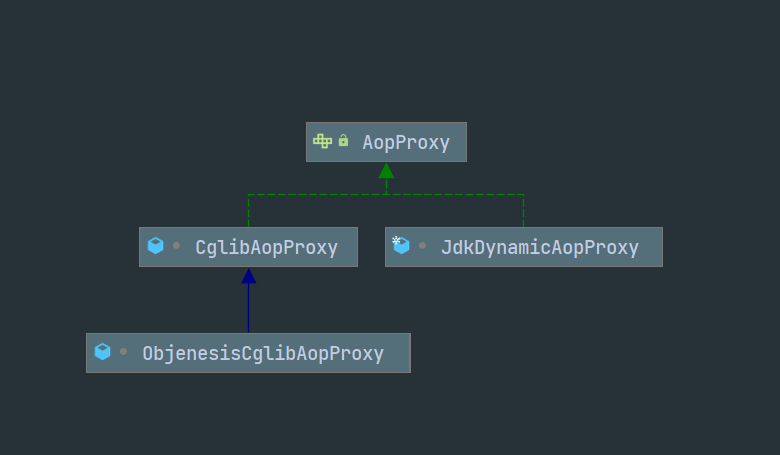EnableTransactionManagement注解解析来看AOP
基于spring 5.3.5版本源码分析
1. EnableTransactionManagement注解
EnableXXX类的注解主要依赖于@Import注解进行拓展。
@Target(ElementType.TYPE)
@Retention(RetentionPolicy.RUNTIME)
@Documented
@Import(TransactionManagementConfigurationSelector.class)
public @interface EnableTransactionManagement {
boolean proxyTargetClass() default false;
AdviceMode mode() default AdviceMode.PROXY;
int order() default Ordered.LOWEST_PRECEDENCE;
}
通过代码可以知道,主要的逻辑都是通过 TransactionManagementConfigurationSelector 来实现的。
2. TransactionManagementConfigurationSelector类
public class TransactionManagementConfigurationSelector extends AdviceModeImportSelector<EnableTransactionManagement> {
@Override
protected String[] selectImports(AdviceMode adviceMode) {
switch (adviceMode) {
case PROXY:
return new String[] {AutoProxyRegistrar.class.getName(),
ProxyTransactionManagementConfiguration.class.getName()};
case ASPECTJ:
return new String[] {determineTransactionAspectClass()};
default:
return null;
}
}
private String determineTransactionAspectClass() {
return (ClassUtils.isPresent("javax.transaction.Transactional", getClass().getClassLoader()) ?
TransactionManagementConfigUtils.JTA_TRANSACTION_ASPECT_CONFIGURATION_CLASS_NAME :
TransactionManagementConfigUtils.TRANSACTION_ASPECT_CONFIGURATION_CLASS_NAME);
}
}
有代码可以看出来该类继承 AdviceModeImportSelector 类。分为了两种情况根据AdviceMode
- AdviceMode.PROXY
这个也是默认情况,主要使用的是JDK代理实现通知 - AdviceMode.ASPECTJ
使用ASPECTJ来实现通知
3. AutoProxyRegistrar类
AutoProxyRegistrar类实现了ImportBeanDefinitionRegistrar接口。通过获取EnableTransactionManagement注解的值来确定使用何种模式以及何种代理来实现Aop.
public class AutoProxyRegistrar implements ImportBeanDefinitionRegistrar {
@Override
public void registerBeanDefinitions(AnnotationMetadata importingClassMetadata, BeanDefinitionRegistry registry) {
boolean candidateFound = false;
Set<String> annTypes = importingClassMetadata.getAnnotationTypes();
for (String annType : annTypes) {
AnnotationAttributes candidate = AnnotationConfigUtils.attributesFor(importingClassMetadata, annType);
if (candidate == null) {
continue;
}
Object mode = candidate.get("mode");
Object proxyTargetClass = candidate.get("proxyTargetClass");
if (mode != null && proxyTargetClass != null && AdviceMode.class == mode.getClass() &&
Boolean.class == proxyTargetClass.getClass()) {
candidateFound = true;
//设置代理创建者AutoProxyCreator
if (mode == AdviceMode.PROXY) {
AopConfigUtils.registerAutoProxyCreatorIfNecessary(registry);
//设置使用代理的方式
if ((Boolean) proxyTargetClass) {
AopConfigUtils.forceAutoProxyCreatorToUseClassProxying(registry);
return;
}
}
}
}
}
}
-
注入InfrastructureAdvisorAutoProxyCreator到Spring容器
该类是一个InstantiationAwareBeanPostProcessor实现类。通过postProcessBeforeInstantiation方法或者postProcessAfterInitialization来创建代理。
//AbstractAutoProxyCreator#postProcessAfterInitialization
@Override
public Object postProcessAfterInitialization(@Nullable Object bean, String beanName) {
if (bean != null) {
Object cacheKey = getCacheKey(bean.getClass(), beanName);
if (this.earlyProxyReferences.remove(cacheKey) != bean) {
return wrapIfNecessary(bean, beanName, cacheKey);
}
}
return bean;
}AbstractAutoProxyCreator#wrapIfNecessary用来创建代理对象如果有advice的情况
protected Object wrapIfNecessary(Object bean, String beanName, Object cacheKey) {
if (StringUtils.hasLength(beanName) && this.targetSourcedBeans.contains(beanName)) {
return bean;
}
if (Boolean.FALSE.equals(this.advisedBeans.get(cacheKey))) {
return bean;
}
if (isInfrastructureClass(bean.getClass()) || shouldSkip(bean.getClass(), beanName)) {
this.advisedBeans.put(cacheKey, Boolean.FALSE);
return bean;
}
// 获取回调拦截器(AOP核心:代理和回调拦截器)
Object[] specificInterceptors = getAdvicesAndAdvisorsForBean(bean.getClass(), beanName, null);
if (specificInterceptors != DO_NOT_PROXY) {
this.advisedBeans.put(cacheKey, Boolean.TRUE);
Object proxy = createProxy(
bean.getClass(), beanName, specificInterceptors, new SingletonTargetSource(bean));
this.proxyTypes.put(cacheKey, proxy.getClass());
return proxy;
}
this.advisedBeans.put(cacheKey, Boolean.FALSE);
return bean;
} -
设置代理方式,false为jdk代理,true为cglib代理
在代理加入了切面的实现
4. ProxyTransactionManagementConfiguration类
这个配主要管理配置代理事务
- 创建TransactionAttributeSource对象
- 创建TransactionInterceptor,依赖TransactionAttributeSource
- 创建BeanFactoryTransactionAttributeSourceAdvisor属性通知器。依赖创建TransactionAttributeSource、创建TransactionInterceptor。
4.1 AnnotationTransactionAttributeSource类
方法主要用来解析注解@Transactional。同时还兼容了jta和ejb。Spring的@Transactional解析类 SpringTransactionAnnotationParser
默认AnnotationTransactionAttributeSource的创建为只能公共方法能够使用@Transactional注解
4.2 TransactionInterceptor类
主要处理@Transactional注解切面,执行方法的处理。
5 事务执行逻辑
事务执行分为两步:
- 代理对象创建
- 代理对象执行方法
5.1 代理对象创建
在 AbstractAutoProxyCreator 类继承了 SmartInstantiationAwareBeanPostProcessor 通过 AbstractAutoProxyCreator#postProcessAfterInitialization 来创建代理对象。
public Object postProcessAfterInitialization(@Nullable Object bean, String beanName) {
if (bean != null) {
Object cacheKey = getCacheKey(bean.getClass(), beanName);
if (this.earlyProxyReferences.remove(cacheKey) != bean) {
//创建代理
return wrapIfNecessary(bean, beanName, cacheKey);
}
}
return bean;
}
protected Object wrapIfNecessary(Object bean, String beanName, Object cacheKey) {
//省略部分代码
//获取要代理类是否含有切面-创建代理
Object[] specificInterceptors = getAdvicesAndAdvisorsForBean(bean.getClass(), beanName, null);
if (specificInterceptors != DO_NOT_PROXY) {
this.advisedBeans.put(cacheKey, Boolean.TRUE);
//创建代理
Object proxy = createProxy(
bean.getClass(), beanName, specificInterceptors, new SingletonTargetSource(bean));
this.proxyTypes.put(cacheKey, proxy.getClass());
return proxy;
}
this.advisedBeans.put(cacheKey, Boolean.FALSE);
return bean;
}
通过在代理类中设置切面的数据,然后创建代理类为后续的执行提供切面的功能。
5.2 代理对象执行方法
代理类的执行我们首先要了解代理类是如何创建的。首先来了解一下Spring中AOP代理的类图结构:

public interface AopProxy {
Object getProxy();
Object getProxy(@Nullable ClassLoader classLoader);
}
这个就是创建代理的接口。下面来看一下实现用CglibAopProxy举例分析,代理创建就是cglib的标准创建方式。然后通过设置类的Callback来将切面结合到里面。看一下代码:
@Override
public Object getProxy(@Nullable ClassLoader classLoader) {
//省略部分代码
Enhancer enhancer = createEnhancer();
if (classLoader != null) {
enhancer.setClassLoader(classLoader);
if (classLoader instanceof SmartClassLoader &&
((SmartClassLoader) classLoader).isClassReloadable(proxySuperClass)) {
enhancer.setUseCache(false);
}
}
enhancer.setSuperclass(proxySuperClass);
enhancer.setInterfaces(AopProxyUtils.completeProxiedInterfaces(this.advised));
enhancer.setNamingPolicy(SpringNamingPolicy.INSTANCE);
enhancer.setStrategy(new ClassLoaderAwareGeneratorStrategy(classLoader));
//重要方法:获取Callback
Callback[] callbacks = getCallbacks(rootClass);
Class<?>[] types = new Class<?>[callbacks.length];
for (int x = 0; x < types.length; x++) {
types[x] = callbacks[x].getClass();
}
//设置CallbackFilter
enhancer.setCallbackFilter(new ProxyCallbackFilter(
this.advised.getConfigurationOnlyCopy(), this.fixedInterceptorMap, this.fixedInterceptorOffset));
enhancer.setCallbackTypes(types);
return createProxyClassAndInstance(enhancer, callbacks);
}
上面比较重要的一个方法就是 getCallbacks 方法。主要用来创建代理对象的Callback(这里主要是cglib的MethodInterceptor):
Callback aopInterceptor = new DynamicAdvisedInterceptor(this.advised);
创建了一个动态通知拦截器。 DynamicAdvisedInterceptor 是 CglibAopProxy 内部静态类。
private static class FixedChainStaticTargetInterceptor implements MethodInterceptor, Serializable {
//省略代码
@Override
@Nullable
public Object intercept(Object proxy, Method method, Object[] args, MethodProxy methodProxy) throws Throwable {
//省略了�部分无关紧要的代码
Object oldProxy = null;
boolean setProxyContext = false;
Object target = null;
TargetSource targetSource = this.advised.getTargetSource();
if (this.advised.exposeProxy) {
// Make invocation available if necessary.
oldProxy = AopContext.setCurrentProxy(proxy);
setProxyContext = true;
}
// Get as late as possible to minimize the time we "own" the target, in case it comes from a pool...
target = targetSource.getTarget();
Class<?> targetClass = (target != null ? target.getClass() : null);
List<Object> chain = this.advised.getInterceptorsAndDynamicInterceptionAdvice(method, targetClass);
Object retVal;
// Check whether we only have one InvokerInterceptor: that is,
// no real advice, but just reflective invocation of the target.
if (chain.isEmpty() && Modifier.isPublic(method.getModifiers())) {
//跳过代理直接在线目标类的方法
Object[] argsToUse = AopProxyUtils.adaptArgumentsIfNecessary(method, args);
retVal = methodProxy.invoke(target, argsToUse);
}
else {
//创建一个cglib方法Invocation去执行
retVal = new CglibMethodInvocation(proxy, target, method, args, targetClass, chain, methodProxy).proceed();
}
retVal = processReturnType(proxy, target, method, retVal);
return retVal;
}
}
创建的 CglibMethodInvocation 最终是执行了 ReflectiveMethodInvocation#proceed 方法:
@Override
@Nullable
public Object proceed() throws Throwable {
if (this.currentInterceptorIndex == this.interceptorsAndDynamicMethodMatchers.size() - 1) {
return invokeJoinpoint();
}
Object interceptorOrInterceptionAdvice =
this.interceptorsAndDynamicMethodMatchers.get(++this.currentInterceptorIndex);
if (interceptorOrInterceptionAdvice instanceof InterceptorAndDynamicMethodMatcher) {
InterceptorAndDynamicMethodMatcher dm =
(InterceptorAndDynamicMethodMatcher) interceptorOrInterceptionAdvice;
Class<?> targetClass = (this.targetClass != null ? this.targetClass : this.method.getDeclaringClass());
if (dm.methodMatcher.matches(this.method, targetClass, this.arguments)) {
return dm.interceptor.invoke(this);
}
else {
return proceed();
}
}
else {
//执行实现了MethodInterceptor接口的方法
return ((MethodInterceptor) interceptorOrInterceptionAdvice).invoke(this);
}
}
这里对于@Transactional注解来说 ((MethodInterceptor) interceptorOrInterceptionAdvice).invoke(this) 这行代码里面的 MethodInterceptor实现就是前面在 ProxyTransactionManagementConfiguration 里面实例化的 TransactionInterceptor 类。在这个类里面包含了处理整个事务
6. 总结
